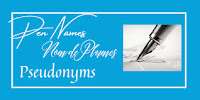Many writers choose to hide their true identity and publish their works under pen names, sometimes referred to by the French phrase nom de plume, or the really fancy word, pseudonym. Why is that? Why wouldn’t you want to use your own name? After all, don’t you want proclaim to the world, “Hey, I wrote that!”?
According to Jennifer
Sommersby, a/k/a Eliza Gordon, there are four primary reasons why a writer
chooses to use a pen name: Confidentiality, Anonymity, Branding, and Gender
Respect. Regarding Confidentiality:
Some writers want and/or need to keep
their writing life completely separate from their day-to-day life, so that’s
where a top-secret pen name might come into play. It’s very freeing to know you
can write about something naughty or scary, and it won’t come up at a board
meeting or in your employee review with an ultraconservative or snobby boss.
As for Anonymity? Many writers are introverts, i.e., they
are not “attention-seeking weirdos.” Or, they want to maintain their privacy,
especially “. . . after experiencing threats or other harm to their
person or families.” Moreover, “Some writers want to make sure their kids or
partners are protected from outside attention.”
Branding is another reason. If you write in different
genres, having two names keeps the author’s brands separate. Can you imagine if
Dr. Seuss also wrote erotica? (Maybe he did, but it certainly wasn’t under the name
Dr. Seuss.) Or, “Think about Nora Roberts vs. JD Robb, though. Same author but
two VERY different styles of books, right?” But, having two names can be very
confusing at book signings.
Finally, there’s Gender Respect. “[T]he name on the front
of a book can have an impact on a buyer’s choice.” Think of J. K. Rowling,
author of the Harry Potter series. Rowling’s publishers, believing that
the stories would appeal to both boys and girls, recommended using initials
(J.K.) and not the author’s name (Joanne). And Rowling’s not the only example. “Did
you know George Eliot, acclaimed novelist and poet who wrote Middlemarch and
Silas Marner, was actually a woman? Her real name was Mary Anne Evans.”
How do you find a pen name? One of the most famous is Mark
Twain, the pseudonym of Samuel Langhorne Clemens. How he got from Clemens to
Twain is very interesting.
According to the blog Connell Guides, “Before “Mark Twain” he was
“Thomas Jefferson Snodgrass.” And before “Thomas Jefferson Snodgrass” he was
“Sieur Louis de Conte,” “John Snook” and even “Josh.” But how did he settle on “Mark
Twain”? Connell Guides continues:
Up until now there have been a
number of competing theories about Clemens’s pseudonym. Most popular is the
suggestion that the name derived from the riverboat call, “by the mark, twain.”
Twain was an old-fashioned way of saying two, and the call referred to sounding
a depth of two fathoms, which was just safe enough for a steamboat travelling
down the Mississippi. The problem with this interpretation is that “twain”
would have been an uncommon word choice on the Mississippi – [research by Kevin]
MacDonnell . . . shows that Clemens’s own journals from his steamboat
days use “mark two” instead of “mark twain.
The Nevada Sentinel newspaper claimed that the name
came from the way a local saloon in Virginia City, Nevada kept a tally of
Clemens’s bar bill by making chalk marks on the wall. “Clemens supposedly asked
the barman to “mark twain” against his tab so often that the phrase became a
nickname.”
Clemens himself debunked the The
Nevada Sentinel’s claim in a letter, which reads:
‘Mark Twain’
was the nom de plume of one Captain Isaiah Sellers, who used to write river
news over it for the New Orleans Picayune: he died in 1863 and as he could no
longer need that signature, I laid violent hands upon it without asking
permission of the proprietor's remains. That is the history of the nom de plume
I bear.
Straight
from the horse’s mouth. Must be true, right? Well, according to the Connell
Guides blog, “MacDonnell, however, argues that this response is only a
symptom of Clemens’s notorious tendency to tell tall tales and stretch the
truth.” The blog elaborates:
MacDonnell’s
research led him to discover a sketch that uses the name in 1861, two years
before Clemens says he adopted it. The magazine in question was the comedic
journal Vanity Fair (unrelated
to today’s Vanity Fair) – which
Clemens later referred to as an early influence on his work. The sketch depicts
a group of Charleston mariners who are “abolishing the use of the magnetic
needle, because of its constancy to the north.” The characters involved are
named “Mr. Pine Knott,” “Lee Scupper,” and “Mark Twain.
The three names are nautical puns: the first for dense
wood, the second for a drain and the third for shallow depth. Clemens took a
liking to the latter, adapted it and invented the Captain Sellers story later
in order to promote his burgeoning series of riverboat writings.
Hmmm. A tall tale about a fake
name? Seems like something Mark Twain would do. Now, if you’ll excuse me, I
need to go whitewash a fence.
(Sources: Why
do writers use pen names? — Eliza Gordon; Biography - Mark
Twain House; and The
origin of Mark Twain’s name – Connell Guides.)











